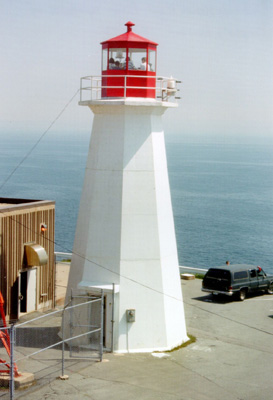 Chebucto Head Lighthouse
Chebucto Head Lighthouse
Note the road to the lighthouse is gated as there has been vandalism in the area. Visitors will have to park off road at the gate and walk in.
- View No Ka Oi Drone Video - Chebucto Head, Duncans Cove, Nova Scotia, Canada
- View No Ka Oi Drone Video - Chebucto Head to N'or East'r, pennant hbr, Nova Scotia, Canada
Chebucto Head has had four lighthouses and several keeper's houses.
The current lighthouse is a white octagonal concrete tower with a red aluminum lantern, built in 1967.
ACKNOWLEDGEMENT: Contributor: Dan Conlin, Kathy Brown, Lise Chapman
Photo - © Chris Mills, Chebucto Head Lighthouse c. 1995
Early History
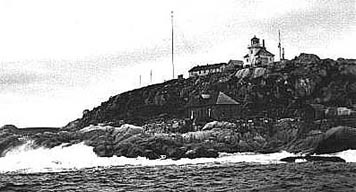 Chebucto Head has had four lighthouses and several keeper's houses.
Chebucto Head has had four lighthouses and several keeper's houses.
This is the first lighthouse at Chebucto Head, built in 1872, a square wooden tower painted white with a dwelling attached. Below it, on the rocks by the shore, you can see the fog signal building. It housed steam foghorn equipment transferred from Sambro Lighthouse.
The second lighthouse at Chebucto Head was a concrete tower with a red lantern, built in about 1928. The photograph below, of keeper Edward Gallagher and his family, plus oral history interviews, proved it's existence. The photograph also shows the comfortable keeper's house of that era. The lighthouse was destroyed in about 1940 because the site was needed for a gun gun battery. If you stand at the current lighthouse and look out to sea, you can see a house projecting from the cliff. This house is built on the foundation of an observation post which was part of the battery.
Photo - © Nova Scotia Archives and Records Management, Department of Transport Collection
The First Chebucto Head Lighthouse
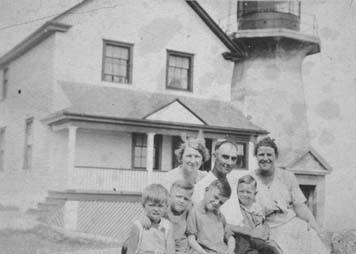 The Second Chebucto Head Lighthouse (c. 1928)
The Second Chebucto Head Lighthouse (c. 1928)
This is Keeper Edward Gallagher and his family in front of the lighthouse.
ACKNOWLEDGEMENT: Contributor: Dan Conlin, Kathy Brown, Lise Chapman.
Photo - Courtesy Jim Gallagher
Later History
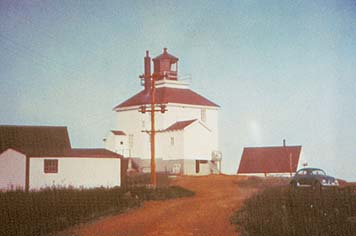 This is the third lighthouse that was built in 1940, a square white building with an iron lantern on the apex of the roof. This combined dwelling and lighthouse was what we call in east coast lighthouse architecture, a "cupola lighthouse." This building still stands and the footings for the tower are apparently still visible in the attic, they have just been covered over with roofing shingles. (Look at Gilberts Cove for a similar lighthouse.)
This is the third lighthouse that was built in 1940, a square white building with an iron lantern on the apex of the roof. This combined dwelling and lighthouse was what we call in east coast lighthouse architecture, a "cupola lighthouse." This building still stands and the footings for the tower are apparently still visible in the attic, they have just been covered over with roofing shingles. (Look at Gilberts Cove for a similar lighthouse.)
This lighthouse style originated in the 1870s and was popular for shorter range coastal lights which did not require a huge lens structure. The medium sized lantern could be accommodated on the dwelling roof and thus combine two structures in one. This is a rare late example of this style as they were most popular at the turn of the century and are seldom seen after the 1930s. It is an interesting example of a traditional design combined with mass produced wartime construction techniques. It looks very much like a two-story wartime house!
This is wartime lighthouse had to be constructed when the large Chebucto Head gun battery occupied the site of the 1872 Chebucto Head lighthouse. At this time a lighthouse at the head was needed more than ever before to help guide the enormous number of convoy vessels in and out of Halifax Harbour. As a lighthouse built to safeguard the movement of Battle of the Atlantic Convoys, this building is directly associated with an important national event in Canadian history.
Keepers living in this dwelling were involved in pioneering automation programs in the 1970s which saw de-staffed lighthouses such as Maughers Beach and Devils Island controlled remotely from Chebucto Head. This automation eventually spread to all the lighthouses in the Maritime region.
Photo - © Courtesy Anne Marie Flemming, The Third Chebucto Head Lighthouse c. 1950
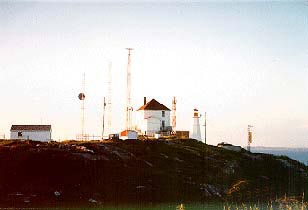 This photo shows clearly the two lighthouses after the lantern was removed from the second lighthouse. It was used for storage after a modern bungalow was built for the keeper in the 1960's. Much later, it was turned back into a house and occupied by the Guptill family after the lighthouse was automated.
This photo shows clearly the two lighthouses after the lantern was removed from the second lighthouse. It was used for storage after a modern bungalow was built for the keeper in the 1960's. Much later, it was turned back into a house and occupied by the Guptill family after the lighthouse was automated.
This more recent view shows the current concrete light on the right, and to the left of it the keeper's house/third lighthouse. Chebucto Head has been the site of traffic control for Halifax Harbour and this shows the lighthouse when it was surrounded by aerials and communication equipment. Much of this is now gone because the Traffic Control has been moved to Bedford Basin where the controllers view the harbour by radar. It is interesting to listen to them on marine radio inquiring as to fog conditions and the identification of some of the targets that they see.
Chebucto Head Light Station with Fourth Lighthouse c. 1995
Note communication aerials. At this this time the station was the traffic monitoring center for Halifax Harbour.
ACKNOWLEDGEMENT: Contributor: Dan Conlin, Kathy Brown, Lise Chapman
Photo - © Kathy Brown
CHEBUCTO HEAD TODAY
Sometime during the evening of the 24th or early morning of the 25th of May 2004 the keeper's house burned to the ground. The head was shrouded in dense fog, and the situation was not discovered till later in the day on the 25th when technicians arrived to check out a malfunction at the lighthouse. The keepers house was a total loss. The fire is judged to have been suspicious but those responsible have never been found. The site has been cleaned up and there is now no sign that the house, which was the WW II lighthouse with the lantern removed, ever stood on the knoll to the right of the parking lot.
The Chebucto Head Lighthouse Society was planning to start work on restoring the keeper's house on the weekend after the fire. The house is sady missed by residents of Halifax.
The lighthouse is a very popular destination for weekend hikers, berry pickers, shipwreck divers and people who drive there for the view of the ocean, storms, passing ships and whales. As such it has a popular landmark status.
 Chebucto Head Lighthouse Society
Chebucto Head Lighthouse Society
Chebucto Head Light Station 2003
The Chebucto Head Lighthouse Society was a community group formed in January 2003 by residents of Duncan's Cove and Chebucto Head who wanted to preserve Chebucto Head Lighthouse. As the Department of Fisheries and Oceans (DFO) was going through the process of divestiture of the site (including keeper's house and surrounding property), CHLS started working towards several primary goals:
- a) To preserve the Chebucto Head Lighthouse Site, including its historic buildings (lighthouse and keeper's house) for future uses within the local adjacent communities.
- To collect information on the natural and maritime history of the site, its buildings and surrounding area (including artifacts, photographs, lore and oral histories), making it available to the public.
- b) To designate restored space in the keeper's house for a small facility, which could be leased as a business, to be operated in concordance with the objects of the society.
- c) To provide communal space to be utilized for public educational and cultural purposes, especially those relating to the natural, cultural and maritime history of the site and the region.
- d) To support the protection of the environmentally fragile landscape, the coastal barrens, around the Chebucto Head Site. To pursue any developments of the site under strict mandates of environmental sustainability.
Chebucto Head Lightkeeper's House
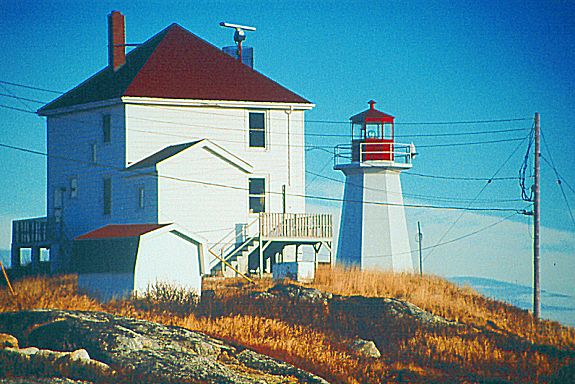 This keepers house shown in the foreground was destroyed by fire on May 27th, 2004.The radar shown in the photo was mounted on a tower behind the house.
This keepers house shown in the foreground was destroyed by fire on May 27th, 2004.The radar shown in the photo was mounted on a tower behind the house.
The society gained members from all over Nova Scotia, who felt very strongly that Chebucto Head Lighthouse should be preserved and public access to the site should be maintained. The Society carried out a visitor's survey at Chebucto Head, and arranged a lease with DFO.
Unfortunately, just as they were about to begin work to preserve and repair the house it burned to the ground on a very foggy night. The origin of the fire was not determined, but it is regarded as suspicious. After the fire, the society was unable to raise funds to replace the keeper's house and the lighthouse now stands a very lonely sentinel at the entrance to Halifax Harbour. The property, a sensitive coastal ecologial area, is still owned by DFO.
The Society has abandoned plans to rebuild, but is still actively involved in maintaining public access to the Chebucto Head site, and in future would like to install an interpretive plaque. Most of the surrounding Crown land has been designated as a Nature Reserve by the provincial government, and the hope is, that the Chebucto Head site will eventually become a part of this protected area. Negotiations are on-going between DFO and the province.
If you are interested in receiving further information about the Chebucto Head Lighthouse Society, please contact NSLPS and your mail will be forwarded.
ACKNOWLEDGEMENT: Contributor: Dan Conlin, Kathy Brown, Lise Chapman
Photo - Courtesy Lise Chapman
Chebucto Head Lighthouse Locator Map
On the head at the west entrance to Halifax Harbour.
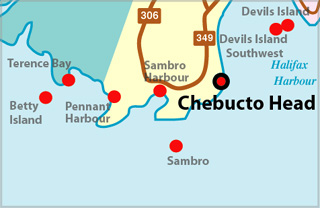
CHEBUCTO HEAD I - Light Details
- Location: On head, west entrance to Halifax Harbour
- Standing: This light is no longer standing.
- Operating: This light is no longer operating.
- Began: 1872
- Year Lit: 1872
- Structure Type: Square wood tower, white, dwelling attached
- Light Characteristic: Flashing White (1922)
- Tower Height: 022ft feet high.
- Light Height: 132ft feet above water level.
History Items for This Lighthouse
- 1872 - 1883 - catatropic lens, revolving white (60s), 18m
- 1892 - steam fog whistle from Sambro established
- 1912 - changed to occulting white - 1913 - changed to group flashing white
- 1922 - catatropic long focus lens, group flashing white (20s) - 1930 - operating
CHEBUCTO HEAD II - Light Details
- Location: On head, west entrance to Halifax Harbour
- Standing: This light is no longer standing.
- Operating: This light is no longer operating.
- Began: c. 1928
- Year Lit: c. 1928
- Structure Type: Concrete tower, red lantern
History Items for This Lighthouse
- c.1928 - replaced original tower of 1872
- 1941 - replaced lighthouse of 1928 - catatropic long focus lens, group flashing white (20s)
- New tower built c.1940 to replace #2 tower. New tower moved approx 1/2 mile north of original position.
CHEBUCTO HEAD III - Light Details
- Location: 1/2 mile north of Chebucto Head, west entrance to Halifax
- Standing: This light is no longer standing.
- Operating: This light is no longer operating.
- Began: c. 1940
- Year Lit: c. 1940
- Structure Type: Square white dwelling, red iorn lantern on apex of roof
- Light Characteristic: Flashing White
- Light Height: 162ft feet above water level.
History Items for This Lighthouse
- 3rd tower replaced (moved approx 65' north)
CHEBUCTO HEAD IV - Light Details
- Location: 1/2 mile north of Chebucto Head, west entrance to Halifax Harbour
- Standing: This light is still standing.
- Operating: This light is operational
- Automated: All operating lights in Nova Scotia are automated.
- Date Automated: Automated by 1980
- Began: 1872
- Year Lit: 1872
- Structure Type: Octagonal concrete tower, red aluminum lantern
- Light Characteristic: Flashing White (20sec)
- Tower Height: 045ft feet high.
- Light Height: 162ft feet above water level.
History Items for This Lighthouse
- DCB10 lens used until 2003
- DCB10 lens replaced with TRB 300 lens spring 2003
- 1967 - replaced lighthouse of 1941. 1941 lighthouse remained as storage and ;ater as caretaker's dwellling
Lightkeepers for Chebucto Head Lighthouse
- Johnson, Edward 1872-1906
- Holland, Capt. Richard 1906-1928
- Gallagher, E. 1928-1949
- Flemming, S.R. 1949-1980 Last Lightkeeper
- Guptill, Jim 1989-1995 Caretaker
Highlights
- County: HRM
- Region: Halifax Metro
- Body of Water: Halifax Harbour
- Scenic Drive: Halifax / Dartmouth
- Site Access: By Car
- Characteristic: Flashing White (20sec)
- Tower Height: 045 ft
- Height Above Water: 162 ft
- Latitude: 44~30~26.6
- Longitude: 63~31~21.8
- Off Shore: No
- Still Standing: Yes
- Still Operating: No